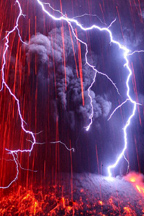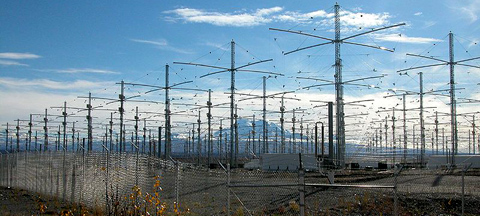Since the 1980s, extensive amounts of time and resources around the world have been focussed on the search for extra-terrestrial intelligence (SETI). One of the primary methods of doing so, is listening for radio transmissions from far away worlds. But how do you decide what frequencies to listen on?
 The main frequency that SETIologists believe would be the primary real-estate for aliens wishing to make themselves known is around what is termed the 'water-hole' at frequencies close to 1.5 GHz. This frequency range includes the so-called hydrogen line (1420.4 MHz) and hydroxyl line (1666 MHz) which are frequencies that are generated by naturally occuring processes within atoms. The other advantage is that Earth's atmosphere, which comprises quite a large percentage of water, is relatively transparent at these frequencies making Earth based observations easier. The logic is that any intelligent life would be as aware of these lines in the spectrum as we are, and would figure that these are good places to transmit. Whether the transparency of the atmosphere at these frequencies on the planets they inhabit would also point them in the direction of the water-hole is a moot point.
The main frequency that SETIologists believe would be the primary real-estate for aliens wishing to make themselves known is around what is termed the 'water-hole' at frequencies close to 1.5 GHz. This frequency range includes the so-called hydrogen line (1420.4 MHz) and hydroxyl line (1666 MHz) which are frequencies that are generated by naturally occuring processes within atoms. The other advantage is that Earth's atmosphere, which comprises quite a large percentage of water, is relatively transparent at these frequencies making Earth based observations easier. The logic is that any intelligent life would be as aware of these lines in the spectrum as we are, and would figure that these are good places to transmit. Whether the transparency of the atmosphere at these frequencies on the planets they inhabit would also point them in the direction of the water-hole is a moot point.
Other frequencies that have been considered are twice the water-hole frequencies (after all, intelligent life would surely be able to multiply by 2 - assuming their number system used the same integers as we do), or 4.462 GHz which is the hydrogen line times pi (because circles are a universal phenomena, right?)
But could we actually receive a transmission on such a frequency? Let's do the link budget calculation...
But path loss is dependent on frequency, and so if a lower frequency was used, say 100 kHz instead of 1500 MHz, the path loss (from Alpha) drops from 368 dB to a more managable 284 dB (84 dB less). Unfortunately the gain of the receive dish also falls from 51 dB to a measly -33 dB (also 84 dB different). But instead of a dish, we could use a long-wire to receive the signals, at 1.5 km long, it would have a gain of 2 dBi, so overall we would gain 33 dB in our link budget calculation.
"A-ha", you say, "but the transmitting antenna would have a lower gain too, so nobody really wins. If I do the maths right, the required transmitter power is now 284+0+0-168 which is 116 dBm or 400 MegaWatts, which is a bit far fetched isn't it?" Maybe, but it's easier to generate 400 Megawatts at 100 kHz than it is at 1.5 GHz (or it is for humans anyway). In fact, this kind of power is generated every day on Earth by... lightning storms.
It may come as no surprise, therefore, that researchers at the University of St Andrews believe that signals that were received in 2009 from exoplanet HAT-P-11b might well have been caused by lightning storms on the distant planet. But what use is this, it doesn't represent extra-terrestrial intelligence, just extra-terrestrial weather (and we already know that even the other planets in our own solar system exhibit different weather characteristics).
 The point, if there is one, is that if we could modulate lightening storms, or perhaps induce them in a way that allowed them to occur in a predictable fashion, we could make signals big enough to be transmitted across inter-stellar space. According to Climate Viewer:
The point, if there is one, is that if we could modulate lightening storms, or perhaps induce them in a way that allowed them to occur in a predictable fashion, we could make signals big enough to be transmitted across inter-stellar space. According to Climate Viewer:
But if lightning can be heard many light years away, perhaps these artificially induced lightning strikes are nothing to do with their stated objective but are actually to 'send messages extra-terrestrially'. Maybe the signals received from HAT-P-11b are not just random lightning storms and despite the Daily Mail claiming that these are not messages from space, perhaps they are an attempt at communication after all. After all, stranger things have been true!

 The main frequency that SETIologists believe would be the primary real-estate for aliens wishing to make themselves known is around what is termed the 'water-hole' at frequencies close to 1.5 GHz. This frequency range includes the so-called hydrogen line (1420.4 MHz) and hydroxyl line (1666 MHz) which are frequencies that are generated by naturally occuring processes within atoms. The other advantage is that Earth's atmosphere, which comprises quite a large percentage of water, is relatively transparent at these frequencies making Earth based observations easier. The logic is that any intelligent life would be as aware of these lines in the spectrum as we are, and would figure that these are good places to transmit. Whether the transparency of the atmosphere at these frequencies on the planets they inhabit would also point them in the direction of the water-hole is a moot point.
The main frequency that SETIologists believe would be the primary real-estate for aliens wishing to make themselves known is around what is termed the 'water-hole' at frequencies close to 1.5 GHz. This frequency range includes the so-called hydrogen line (1420.4 MHz) and hydroxyl line (1666 MHz) which are frequencies that are generated by naturally occuring processes within atoms. The other advantage is that Earth's atmosphere, which comprises quite a large percentage of water, is relatively transparent at these frequencies making Earth based observations easier. The logic is that any intelligent life would be as aware of these lines in the spectrum as we are, and would figure that these are good places to transmit. Whether the transparency of the atmosphere at these frequencies on the planets they inhabit would also point them in the direction of the water-hole is a moot point.Other frequencies that have been considered are twice the water-hole frequencies (after all, intelligent life would surely be able to multiply by 2 - assuming their number system used the same integers as we do), or 4.462 GHz which is the hydrogen line times pi (because circles are a universal phenomena, right?)
But could we actually receive a transmission on such a frequency? Let's do the link budget calculation...
- The path loss from our nearest star, Alpha Centauri, which is 4.37 light years (41,315,094,156,000 km) away at 1.5 GHz is 368 dB.
- If we use a BIG dish, say 30 metres in diameter, to receive the signal, it would have a gain of 51 dBi.
- Let's also assume that the aliens are transmitting using a similar sized dish (and they are pointing it directly at Earth).
- If the signal is very low bandwidth data (say 100 bits per second) we would need a receiver bandwidth of around 100 Hz, giving a noise floor for a cryogenically cooled receiver of -168 dBm.
- The necessary transmitter power to overcome the noise is therefore 368-51-51-168 or 98 dBm or 6.3 MegaWatts.
But path loss is dependent on frequency, and so if a lower frequency was used, say 100 kHz instead of 1500 MHz, the path loss (from Alpha) drops from 368 dB to a more managable 284 dB (84 dB less). Unfortunately the gain of the receive dish also falls from 51 dB to a measly -33 dB (also 84 dB different). But instead of a dish, we could use a long-wire to receive the signals, at 1.5 km long, it would have a gain of 2 dBi, so overall we would gain 33 dB in our link budget calculation.
"A-ha", you say, "but the transmitting antenna would have a lower gain too, so nobody really wins. If I do the maths right, the required transmitter power is now 284+0+0-168 which is 116 dBm or 400 MegaWatts, which is a bit far fetched isn't it?" Maybe, but it's easier to generate 400 Megawatts at 100 kHz than it is at 1.5 GHz (or it is for humans anyway). In fact, this kind of power is generated every day on Earth by... lightning storms.
It may come as no surprise, therefore, that researchers at the University of St Andrews believe that signals that were received in 2009 from exoplanet HAT-P-11b might well have been caused by lightning storms on the distant planet. But what use is this, it doesn't represent extra-terrestrial intelligence, just extra-terrestrial weather (and we already know that even the other planets in our own solar system exhibit different weather characteristics).
 The point, if there is one, is that if we could modulate lightening storms, or perhaps induce them in a way that allowed them to occur in a predictable fashion, we could make signals big enough to be transmitted across inter-stellar space. According to Climate Viewer:
The point, if there is one, is that if we could modulate lightening storms, or perhaps induce them in a way that allowed them to occur in a predictable fashion, we could make signals big enough to be transmitted across inter-stellar space. According to Climate Viewer:DARPA wants to trigger lightning to protect infrastructure, satellites, and use the artificially generated ELF waves to send messages worldwide. Lightning strikes are “triggered” at the University of Florida and University of Arizona, a network of sensors called the Holographic Array for Ionospheric Lightning (HAIL) collects info on these strikes, and HAARP has a large role in the whole process.
But if lightning can be heard many light years away, perhaps these artificially induced lightning strikes are nothing to do with their stated objective but are actually to 'send messages extra-terrestrially'. Maybe the signals received from HAT-P-11b are not just random lightning storms and despite the Daily Mail claiming that these are not messages from space, perhaps they are an attempt at communication after all. After all, stranger things have been true!

add comment
( 561 views )
| permalink
| 



 ( 2.8 / 2365 )
( 2.8 / 2365 )




 ( 2.8 / 2365 )
( 2.8 / 2365 )

